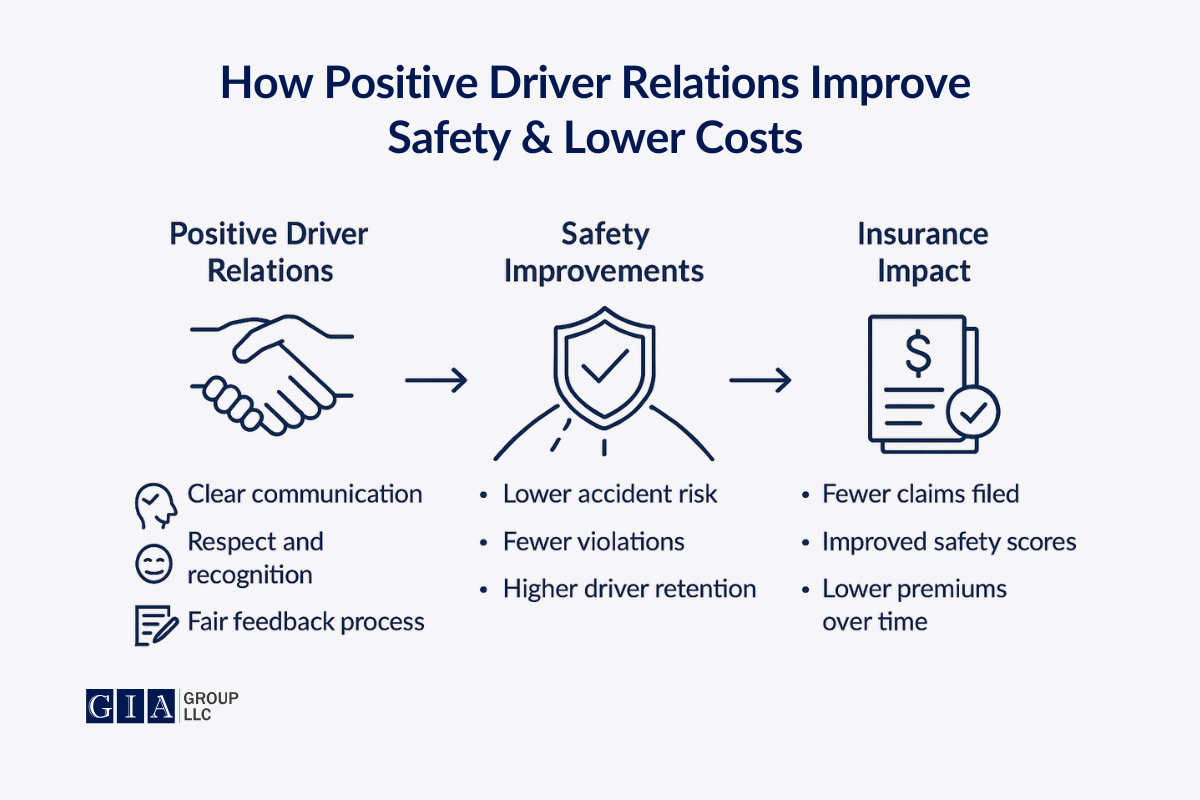In the trucking industry—where every driving decision carries weight—the relationship between drivers and the management is the backbone of road safety and financial efficiency. A driver who feels heard, respected, and properly equipped is far less likely to make a mistake that leads to an accident, a delay, or an insurance claim that puts a dent in company profits.
The recipe is simple: respect, communication, and training. Yet, some companies focus on logistics and cost-cutting, forgetting the human element that keeps the wheels rolling—literally.
How Driver Satisfaction Directly Impacts Road Safety
A study across 49 Japanese trucking companies, surveying 1,028 drivers, confirms that those with proper training, reliable equipment, and a sense of value from their employers were significantly safer on the road. On the flip side, drivers who felt overworked or ignored were far more prone to errors—whether from stress, frustration, or outright exhaustion.

Having a driver behind the wheel of a poorly maintained truck with a ticking clock over their head raises safety concerns. Addressing these issues is not an abstract Human Resources (HR) concern—it’s a direct way to cut the frequency and severity of road accidents, avoid legal troubles, and lower insurance costs.
Communication: The Foundation of Trust and Compliance
A fleet without proper communication is like a truck without brakes—the risks of accidents are getting higher. The best-performing companies set up open feedback loops—driver advisory boards, regular meetings, anonymous reporting systems—to make sure concerns don’t go unheard until they turn into full-blown crises.
Some companies have seen driver satisfaction shoot up just by implementing direct contact lines with management. No bureaucracy, no getting passed around between departments—just straight access to someone who can actually do something about a problem. That kind of system doesn’t just improve morale; it ensures safety issues get flagged and fixed before they may lead to accidents.
Continuous Training and Professional Development
A truck driver needs more skills than gear-shifting and reading directions from a GPS. To perform this job safely and efficiently, it’s essential to develop three key skills: defensive driving, fatigue management, and emergency control. Continuous training initiatives can help to significantly decrease the number of traffic incidents.
Those who deliver continuous training to their drivers experience 22% fewer traffic incidents than establishments without regular training programs, according to National Highway Traffic Safety Administration (NHTSA) statistics. Training is now far more available due to modern technology, which combines telematics and in-cab coaching systems. Drivers receive instant feedback about their behaviors through performance data that lets them modify their actions instead of uncovering problems after incidents occur.
The Role of Incentives and Recognition Programs
People perform better when they feel valued. A driver knowing they’ll get a bonus for maintaining a clean safety record over a set period is more likely to stay sharp on the road. Several trucking industry giants have successfully implemented tiered reward systems that include cash incentives, additional paid leave, or even personal vehicle insurance discounts.
However, recognition isn’t always about money. “Driver of the Month” programs, internal newsletters highlighting top performers, or even a simple shoutout from the management team can make a real difference. People want to be seen not just as cogs in a machine but as professionals doing a tough, demanding job.
Empathy and Well-Being: The Psychological Aspect of Safe Driving
Long-haul trucking is brutal. The hours, the isolation, the unpredictability—it takes a toll. An exhausted, mentally drained driver faces higher risks on the road. Companies that ignore this reality may end up paying the price in accidents, high turnover rates, and higher insurance premiums.
Offering flexible scheduling options, making sure drivers get adequate rest breaks, and providing mental health resources are about making smart, calculated business decisions. A study by the American Transportation Research Institute (ATRI) found that proper fatigue management initiatives led to a 30% drop in fatigue-related accidents. That’s 30% fewer damage, claims, and potential lawsuits.
The Financial Impact: Lower Insurance Premiums Through Driver-Centric Policies
Insurance companies assess risks and determine premiums based on data—data that shows how well a fleet manages its safety. Fleets with clean safety records, well-trained drivers, and proactive risk management strategies consistently get better rates.
Many insurance providers now offer discounts to fleets that integrate telematics, adhere to strict safety training programs, and incentivize good driving behavior. It is possible to cut annual premiums by implementing a fleet-wide safety initiative that reduces accidents and claims.
Let’s summarize
The trucking industry isn’t just about logistics and fuel costs—it’s about people. The drivers on the road carry the load—literally and figuratively. When companies recognize that investing in drivers through open communication, proper training, recognition programs, and well-being initiatives isn’t just good ethics but good business, they see the results in fewer accidents, lower insurance premiums, and a stronger bottom line. A satisfied driver is a safer, more reliable, and more cost-effective asset to the trucking company.
